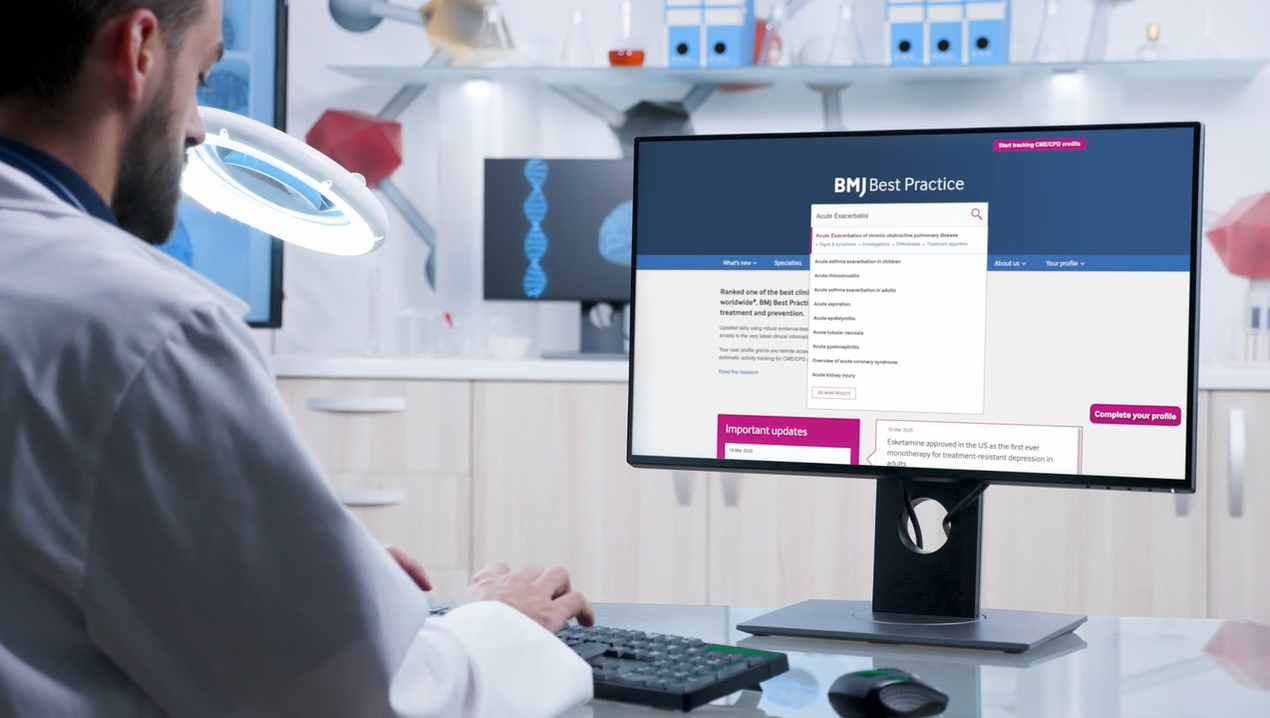Facing the future, fueling the NHS
How BMJ Group is helping deliver the NHS 10-year health plan
The UK’s National Health Service (NHS) 10 year health plan (Fit for the Future), published in July 2025, is the blueprint for transforming England’s health service. It focuses on three radical shifts: moving care from hospital to community, from analogue to digital, and from sickness to prevention. It also calls for higher quality standards, a stronger workforce, innovation, and financial stability.
It is urgent work. Demand is rising, waiting lists are long, and staff are stretched. The Plan states that bold reform is needed.
At BMJ Group, we do not endorse the plan itself. But we do stand shoulder to shoulder with the NHS, supporting its staff and systems as they confront rising demand, long waiting lists, and unrelenting pressures.
At BMJ Group, our longstanding vision of creating a healthier world aligns directly with many of these priorities. Our tools, research, and education programmes make a measurable difference. Here’s how:
The NHS ten year plan dissected

From hospital to community
The plan suggests a shift in the centre of gravity for care, with more services delivered locally and at home. It states that neighbourhood health centres and integrated teams should help keep people well and out of hospital. The new neighbourhood health service encourages a preventative principle by delivering care locally and digitally, at home whenever possible, in neighbourhood health centres when needed, and in hospitals only when necessary.
How BMJ Group helps
Proof in action
An influential study, “Reductions in hospital admissions and mortality rates observed after integrating emergency care: a natural experiment,” showed that reorganising emergency care, with earlier senior decision-making and improved assessment units, significantly reduced hospital admissions and mortality.
Published in BMJ Open in 2012, Boyle and colleagues investigated an integrated acute care model that relocated the medical assessment unit directly into the emergency department. This organisational innovation,with earlier senior clinician input and streamlined assessments, led to statistically significant reductions in both emergency admissions and short-term mortality.
-
Mortality fell: The hospital had the lowest emergency mortality rate of 24 hospitals studied. (A statistically significant drop (p = 0.0149))
-
Admissions dropped: Emergency admissions were cut to the lowest level among peers. (Also highly significant (p = 0.0002))
-
Better outcomes without extra spending: These improvements were achieved simply by reorganising care (moving the assessment unit into emergency medicine and using senior doctors earlier), not by adding new resources

Nearly 13 years later, the 2025 NHS 10-year health plan outlines a complementary strategic shift: bringing care back into the community through neighbourhood health services, helping to relieve hospital burden and improving outcomes. It calls for faster access to the “right professional at the right time,” using integrated teams and digital triage.
From analogue to digital
How BMJ Group helps
Proof in action: virtual wards and telemedicine

- Broader access through remote technology
Speakers described how virtual wards are used to care for frail, rural, or immobile patients, who can now receive hospital-level monitoring via digital tools without travelling. - Meaningful reduction in admissions
By combining remote monitoring with multidisciplinary virtual teams, clinicians helped prevent unplanned admissions by spotting early signs of deterioration and managing conditions proactively. - Improving equity in care
The panel emphasised that digital inclusion is essential. They shared strategies being used across the NHS to ensure patients without home internet, digital skills, or suitable devices could still benefit, for example, via community hubs or telephone support. - Collaboration delivers results
Catriona Watt from Mid Argyll Community Hospital and Gurnak Singh Dosanjh, Deputy CCIO for NHS Leicester, Leicestershire and Rutland, highlighted the power of aligned clinical teams, technology partners, and community services to improve outcomes.
From sickness to prevention
Better prevention is at the heart of the NHS plan, with priorities including tackling obesity, reducing smoking, expanding mental health support, and eliminating cervical cancer. We share this focus because evidence consistently shows that preventing ill health is more effective and more sustainable than treating avoidable disease downstream.
How BMJ Group helps
Our expertise spans research, education, and clinical decision support. Our journals provide the evidence base that informs national policy and public health initiatives, for instance:
Additionally, BMJ Best Practice translates this knowledge into practical guidance, offering clinicians prevention strategies and patient-facing resources for a wide range of conditions.
Proof in action
A recent BMJ analysis found that in 2016–17, almost 1.5 million emergency admissions could have been avoided with stronger preventive care outside hospitals. More recently, BMJ research on HPV vaccination has helped strengthen global calls to eliminate cervical cancer, influencing both UK policy and WHO targets. The study published in The BMJ found that England’s national HPV vaccination programme led to a staggering 90% reduction in cervical cancer risk among women vaccinated at ages 12–13, compared to unvaccinated peers. This benefit was seen across socioeconomic groups, making a powerful equity case for the vaccine’s universal rollout. Public health leaders in the UK have built on this evidence to set a national elimination goal. NHS England, for instance, is aiming to eliminate cervical cancer entirely, backed by these compelling data and reinforced by BMJ findings.
Improving quality and safety
The NHS long-term plan calls for safer, more transparent, and continually improving services. Quality improvement (QI) is central to this ambition, ensuring that healthcare is modern, efficient, and capable of delivering better patient outcomes.
How BMJ Group helps
Proof in action
One recent UK project designed and implemented a new management pathway for rib fractures. It shows how a pathway, which incorporated BMJ Best Practice and local hospital needs, was designed and implemented. It ultimately improved the quality of care. This shows how BMJ Best Practice can help equip frontline staff with the right knowledge and tools to deliver safer, more consistent, and higher-quality care.
Building the workforce
The plan has much to say about training roles, the use of AI in education, and supporting a wide variety of clinical careers.
How BMJ Group helps
Proof in action
In one of BMJ Learning’s early initiatives, we developed eight interactive online modules focused on common rheumatology problems in primary care. These modules were tailored for primary care professionals, specifically general practitioners and primary care nurses. A total of 2,109 users completed these modules, and participants showed statistically significant improvements in knowledge and skills from pre-test to post-test (p < 0.001). Many users reported they would change their practice after completing the modules.
Supporting innovation
The plan aims to make the NHS the most AI-enabled health system in the world, embracing genomics, robotics, and wearable tech.
How BMJ Group helps
Proof in action
A BMJ Digital Health & AI case study tested AI governance for a discharge-prediction model in an NHS trust. The framework spotted data drift early, safeguarding patient safety and ethics.
What the study showed:
Safeguarding patient safety through early detection of AI risk
The project tested a discharge-prediction model for gastrointestinal and oncological surgery using retrospective data from two Dutch hospitals (2017–2022). By monitoring model performance and applying both univariate statistical tests and multivariate PCA error monitoring, the framework could detect essential shifts in respiratory rate data and anomalies caused by data-entry errors and atypical lengths of stay.
Detecting these problems early meant the model could be reviewed and recalibrated before its reliability or fairness was compromised. The study demonstrates how AI governance protects patient safety, ensures ethical oversight, and builds trust among clinicians and health systems. While developed in the Netherlands, the lessons are widely applicable and provide a blueprint for the NHS and other health services to deploy AI transparently, safely, and with full accountability.
Why this matters
The NHS 10-year plan can only succeed if frontline staff have fast access to evidence, the skills to apply it, and systems that work with them, not against them.
BMJ Group provides those essentials – we always have, and always will. Through evidence, education, and innovation, we are helping the NHS deliver a service that is safe, sustainable, and fit for the future.





